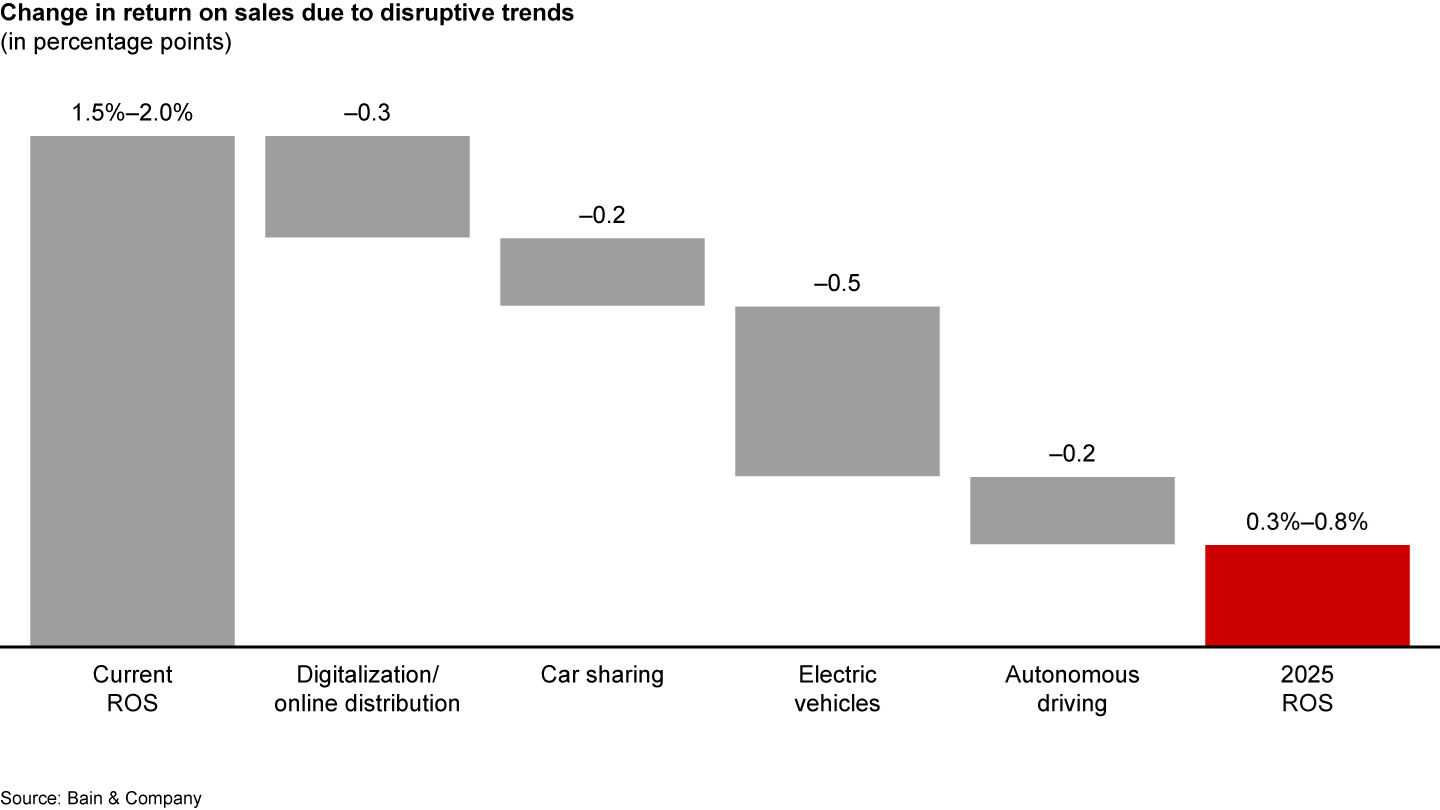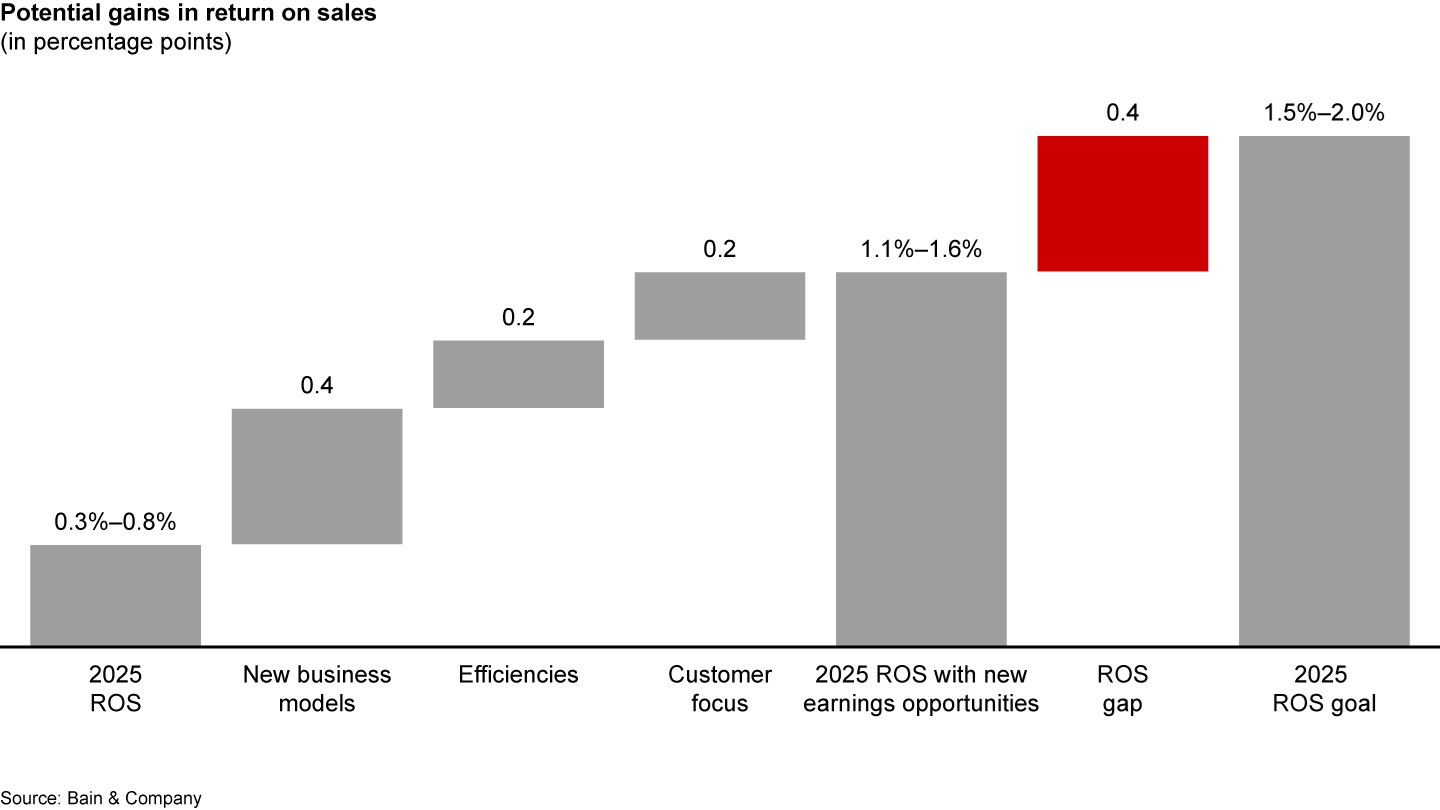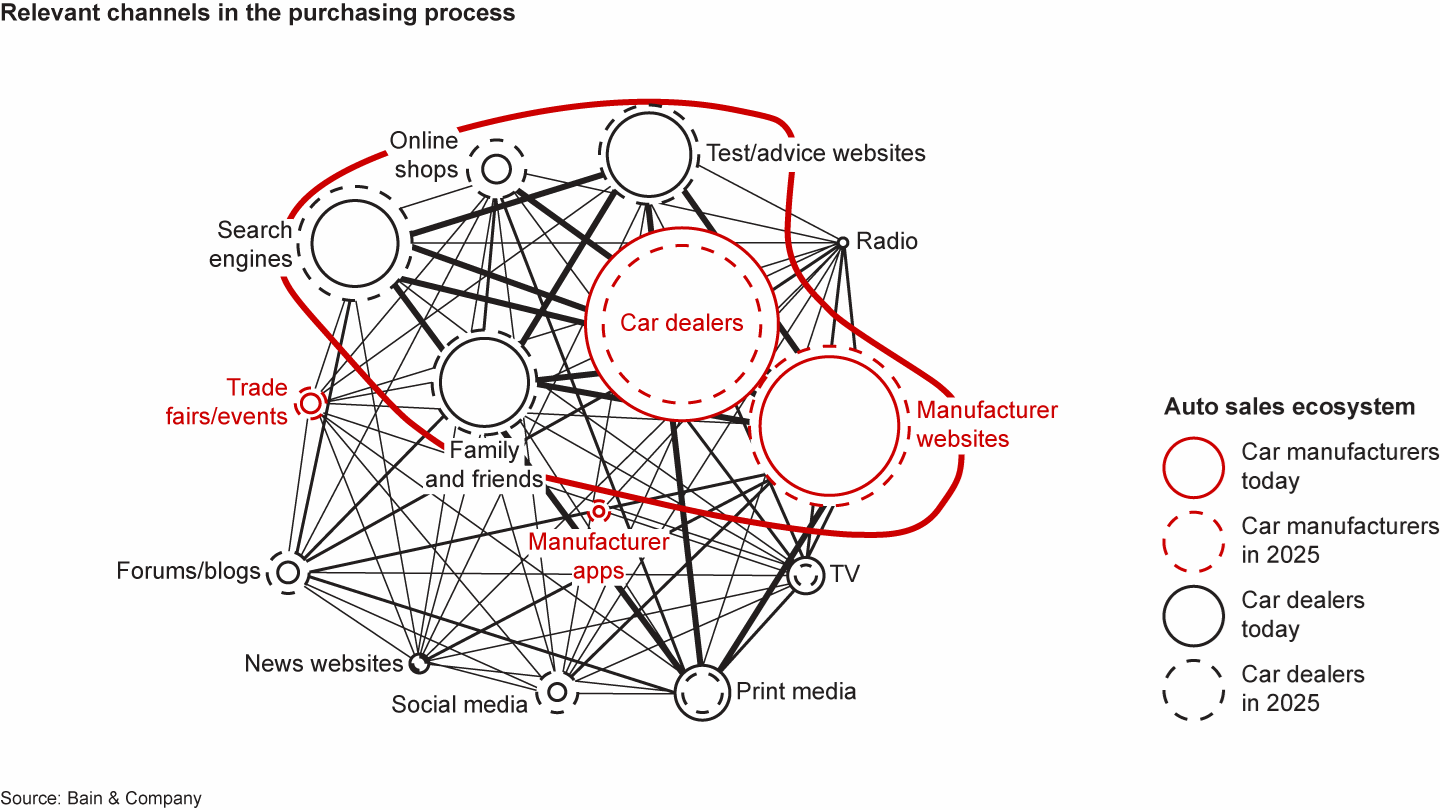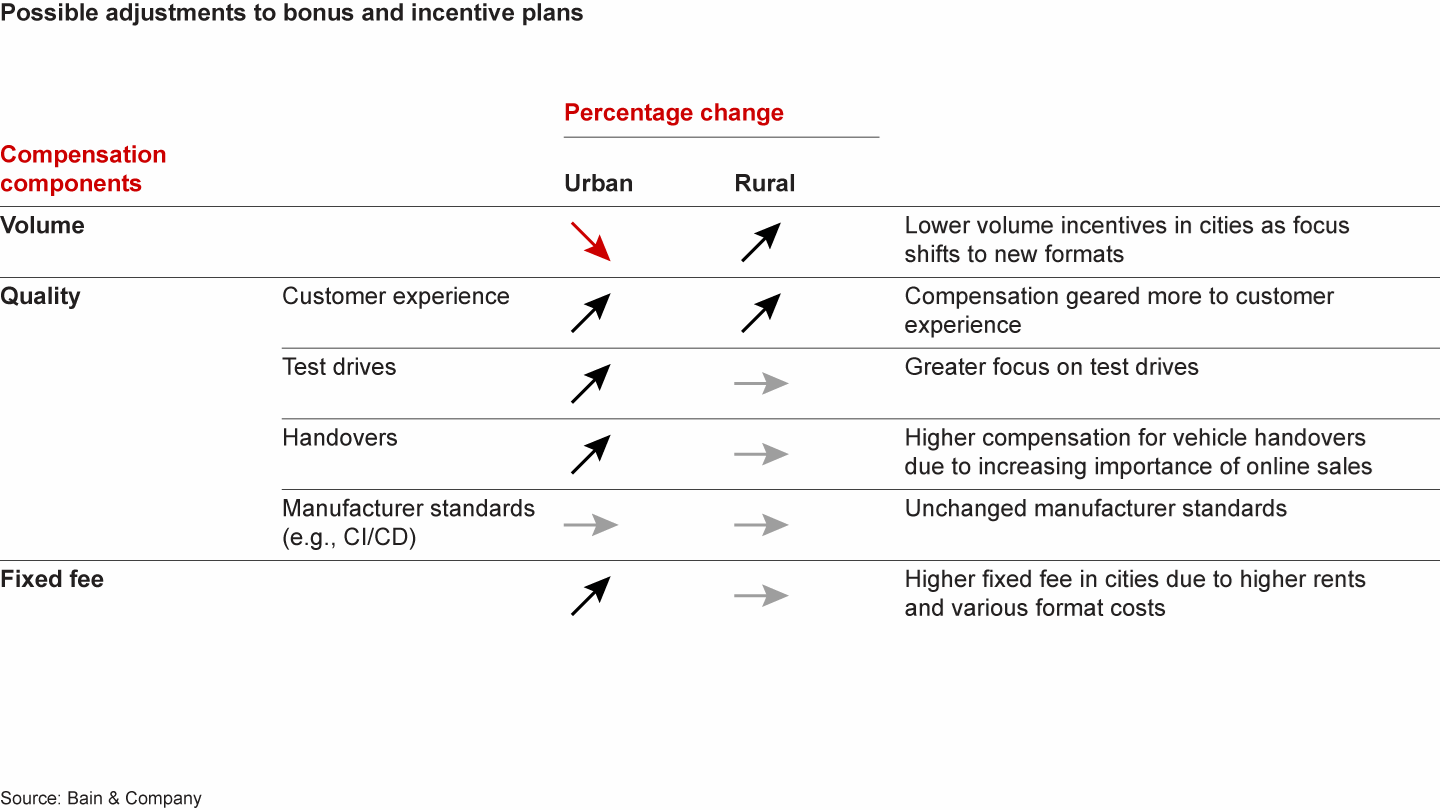Report

Executive summary
The automotive industry is undergoing a fundamental transformation, and manufacturers are bracing themselves for the “automotive endgame.” Five megatrends, which Bain & Company calls the 5 RACES, are the forces behind this disruptive change: real customer focus, autonomous driving, connectivity and digitalization, electric powertrains and shared mobility. These trends have major implications for both manufacturers and the traditional sales model through auto dealerships. While the trends create considerable risk for the industry, they also generate new opportunities.
Digitalization is prompting a growing number of customers to buy vehicles directly from auto manufacturers, at the expense of traditional car dealerships. New mobility services in urban regions are reducing the volume of new car sales, especially to younger customers. Sales of electric vehicles are also growing, and since EVs require less maintenance and fewer replacement parts, the steady increase in sales will erode dealers’ service revenues. In addition, the rise of autonomous driving will result in fewer accidents but also reduce the profitability of car repair shops.
But the same trends that are increasing auto dealers’ business risk are creating opportunities. New business models based on mobility services, such as maintaining and operating car-sharing fleets, offer a particularly attractive source of future income. Manufacturers and dealers can improve their efficiency by merging servicing operations and digitalizing core processes. Finally, big data analysis can help automakers acquire customers more efficiently and better address their needs, strengthening loyalty.
These megatrends will fundamentally transform the profitability of Europe’s auto dealerships. Bain estimates a 1.2-percentage-point reduction in return on sales (ROS) by 2025. At the same time, new earnings opportunities will allow dealers to add up to 0.8 percentage points in ROS, trimming the profitability gap to around 0.4 percentage points. Car manufacturers and dealers can maintain current profitability levels if they act promptly to mitigate the risks and exploit new opportunities, especially in cities, where change is happening fastest.
Industry leaders already are rethinking their sales and marketing organizations. Traditional car dealers are focusing on key customer interactions, in order to improve satisfaction and enhance the car-buying experience; adapting retail formats; and adjusting to activity-based compensation models. In the future, car dealers will arrange test drives, receive vehicle deliveries and service cars. Their role as an information channel and contact point for vehicle configuration will decline. As part of the shift, dealers will develop new retail formats, such as pop-up stores or experience centers in urban locations, and efficient car-servicing facilities on the outskirts. Automakers will largely abandon the current dealer compensation model, based on scaled incentives for new car sales. In its place, they will offer fixed fees plus premiums for specific activities undertaken during the sales process.
The task of realigning sales and marketing will lie for the most part with car manufacturers and their national sales companies. But independent car dealers will also need to rethink commercial operations—ideally in close coordination with their respective manufacturers—and adapt their business model to a changing landscape.
This study focuses on the European car market. While the shift toward omnichannel sales and electric cars is global, and manufacturers and dealers around the world are facing similar challenges, the impact of these trends will vary from region to region.
Full report
The automotive industry is in the midst of fundamental change. The forces behind this transformation are five megatrends, which Bain calls the 5 RACES: real customer focus, autonomous driving, connectivity and digitalization, electric powertrains and shared mobility. Car manufacturers and dealers are under enormous pressure to act.
Connectivity and digitalization, shared mobility, powertrain electrification and autonomous driving are reducing new car sales and lowering maintenance requirements, squeezing the profitability of auto dealerships in the process. At the same time, these trends are paving the way for new business models and greater efficiency. By prioritizing customer satisfaction and the customer experience, auto dealers can tap into new sources of revenue.
Megatrend No. 1: Connectivity/digitalization
Expected scenario 2025: Online purchases account for 37% of new car sales to individuals in Europe, and car manufacturers dominate online retail sales. Urban areas are the most important market for online sales, while most customers in rural areas continue to purchase from traditional car dealers. More than 40% of the vehicle pool is Internet-connected, paving the way for function-on-demand services, which allow customers to add features such as intelligent search for a parking space, either for a limited period or permanently. The bulk of core processes in car retail are digitalized, delivering considerable efficiency gains.
In the coming years, car manufacturers will increase online sales of new cars, a move that will give them full control over product pricing and better price discipline. Today, 42% of German consumers can envision buying their next vehicle online, and interest in online channels is rising. Initially, most online purchases will take place in urban areas, at the expense of sales volume at brick-and-mortar dealerships. Despite that shift, car manufacturers will continue to rely on dealers to seamlessly manage the interactions customers initiate online—for example, by arranging test drives and conveying the experience of the brand. Dealers will act as the car manufacturer’s agent during the vehicle handover and will be compensated on the basis of various activities, such as the number of test drives or handovers.
Using an individual customer ID, a prospective buyer might do research online, get advice from a dealer and then place an order online, without having to enter the same information twice. The ID could also enable the buyer to download software and use the brand’s supplementary digital and physical services. An integrated omnichannel offering of this kind improves sales efficiency and customer focus, and helps keep potential online competitors at bay.
Online sales of new cars are still relatively rare and are usually arranged through online portals or individual car dealers. But some manufacturers, as well as Internet giants like Amazon, are already taking steps to encourage online sales. Tesla has announced that it will sell its electric cars almost exclusively online, shuttering many of its existing stores or using them only as showrooms or information centers for online purchases. The electric carmaker’s radical overhaul of commercial strategy is only possible because Tesla owns its own stores. Meanwhile, Amazon has created a research site for car buyers (Amazon Vehicles), the mega-retailer’s first step toward gaining a foothold in the car business. Customers in the US can use the platform not only to search for pricing information but also to find vehicle specifications and view customer ratings.
Bain estimates that the number of cars sold at traditional brick-and-mortar dealerships in Europe will fall 37% by 2025. Lower sales will inevitably result in consolidation of today's dealership structures, although dealers will continue to play a key role in areas such as test drives, car deliveries and maintenance.
The shift to buying cars directly from manufacturers poses risks to auto dealers’ existing business model, but connectivity and digitalization offer new opportunities. In the future, more new vehicles will have an Internet connection, effectively turning them into digital terminals on wheels. The digital connection will allow dealers to interact effortlessly with customers after the purchase—for example, by arranging the next service check. Dealers can also boost efficiency and profitability by digitalizing core retail processes, both in the front office (e.g., consultations) and in the back office (e.g., data management).
Megatrend No. 2: Shared mobility
Expected scenario 2025: Shared vehicles and networked mobility continue to reduce the demand for new cars in cities. Fewer and fewer urban residents own cars.
In urban areas, new mobility services will become increasingly popular. They will range from traditional car sharing to intelligent, intermodal connections that can be booked with mobile apps. Younger people in particular are embracing mobility services and dispensing with car ownership, attracted by lower cost and convenience. Car sharing and networked transport will further reduce urban car ownership, with fewer private individuals purchasing new cars. By contrast, customers operating car-sharing fleets and limousine services will buy more cars in the future.
Although shared mobility will squeeze sales volumes and margins, especially for urban car dealers, it will create new opportunities in areas such as maintaining and operating car-sharing fleets, which could become a significant source of income. Dealers that deploy their existing capabilities to support new mobility services—for example, in the car servicing business—stand to benefit from this trend.
Megatrend No. 3: Powertrain electrification
Expected scenario 2025: Around 30% of all new cars sold and 6% of all vehicles on the road in Europe have an electric powertrain (battery-powered vehicles, range extenders or hybrids). The electric powertrain in fully battery-powered vehicles significantly reduces maintenance intensity.
Cars with an electric powertrain require less maintenance than those powered by an internal combustion engine. Fully electric vehicles have significantly fewer moving parts (no starter motor, drive belt or clutch) and do not require engine oil. Brake pads receive less wear and tear thanks to EVs’ regenerative braking capability. Bain analyses show that purely battery-powered vehicles have less than half of the maintenance costs of cars powered by an internal combustion engine.
As the number of electric vehicles on the roads grows, car dealers’ servicing business will decline, reducing revenues and profitability, especially in affluent urban areas. One way to boost efficiency and improve profitability is to consolidate service operations into efficient facilities located just outside cities. The transition to electric vehicle technology is happening slowly, however. According to Bain research, an estimated one in ten cars in Europe will be partially or fully electrically powered by 2030, giving dealers sufficient time to adapt their business models.
Megatrend No. 4: Autonomous driving
Expected scenario 2025: Around 2% of newly registered cars in Europe are fully automated (level 4). Autonomous driving and driver assistance systems are lowering the accident rate and reducing car repairs. The number of car owners is also in decline.
With increasing use of driver assistance systems (levels 1 to 3), the number of accidents and incidence of damaged cars will decline. This trend will also affect self-driving vehicles (levels 4 and 5). As a result, the capacity utilization and profitability of car repair shops will decline, affecting a core business on which many dealers rely today.
Autonomous cars also pose a challenge for new car sales. These vehicles will frequently be deployed in fleets—for example, as driverless taxis—reducing the overall demand for private car ownership, especially in urban areas. Bain expects new car sales in Berlin, for instance, to fall 12% by 2030 as use of driverless taxis rises. Owners of autonomous fleets often will buy directly from car manufacturers. They will be tough negotiators and, depending on the customer segment, require specific technical features in their fleets. Adoption of autonomous vehicles will not only reduce sales of new vehicles, it will also affect dealer profitability.
Megatrend No. 5: Real customer focus
Expected scenario 2025: Customer-centric business models are creating new ways to enhance customer satisfaction. Increasingly, offerings are tailored to an individual buyer's needs.
In the auto industry’s digital transformation, aligning with customers and designing individual experiences to increase loyalty will be important goals. Big data analysis will allow leading car manufacturers to acquire significantly more knowledge about their customers, helping them segment products more effectively and better address individual customer needs.
Sophisticated digital support strategies will enable car dealers to continually tailor offerings to individual buyers. The result will be higher average sales per customer. At the same time, loyalty programs employing the same digital tools will help retain existing customers. Manufacturers will offer greater compensation to dealers that excel at creating loyal customers. Leading dealers will build successful digital sales and marketing models in close partnership with national sales companies.
Changing profit pools
Already, the five megatrends are having a major effect on the profitability of the retail car business. Leading manufacturers and dealers are taking actions to lessen the impact and exploit new opportunities.
By 2025, risks associated with the five megatrends will have wiped out around 1.2 percentage points from the industry’s return on sales in Europe (see Figure 1). The growing number of online sales based on a direct distribution model (0.3 percentage points) and the further rise in mobility services (0.2 percentage points) will lead to fewer new car sales. At the same time, the breakthrough of electric vehicles (0.5 percentage points) and autonomous driving (0.2 percentage points) will reduce demand for maintenance and repair services. This will hurt the highly profitable service business, particularly for dealers in urban areas.
Return on sales for Europe’s car dealers will fall significantly by 2025


The megatrends will have the greatest impact in cities—far more so than in rural areas—and much sooner. Faced with these fundamental changes, however, rural car dealers will also have to prepare themselves for a decline in profitability, especially in the car servicing business. In addition, customers will increasingly turn to nearby urban shops and experience centers, putting pressure on rural dealers to adjust their business model.
Tapping earnings potential through realignment. New opportunities linked to the five megatrends offer car dealers a potential ROS gain of 0.8 percentage points (see Figure 2). This means that, even if they fully exploit every opportunity, car dealers will still be unable to completely cushion themselves from a likely decline in earnings. They can generate additional income by building new business models (0.4 percentage points) such as maintaining and operating car-sharing fleets, or installing and running battery-charging stations. Dealers can achieve additional gains by streamlining processes and services (0.2 percentage points). For example, several dealers might join forces and outsource their repair activities to service facilities in the surrounding area. Dealers can strengthen customer experience (0.2 percentage points) by employing big data analysis, addressing individual customer needs and offering new loyalty and incentive models.
At the same time, new earnings opportunities will arise


Unlike their urban counterparts, which will be able to tap into an array of new business possibilities, rural car dealers will have one main option to boost revenues: digitalizing their core processes. Overall, Bain expects a profitability gap of 0.4 percentage points for dealers by 2025.
How to close the profitability gap
Manufacturers will continue to rely on car dealers as a key component of successful vehicle sales in the future. But dealers will need to reposition themselves. Bain’s analysis of customer preferences shows that car dealers are still the most important sales channel in the automotive industry and that they will continue to play a crucial role in the sales system of the future (see Figure 3). Nevertheless, the importance of car dealers in direct sales will decline between now and 2025, as digital channels for purchasing cars grow. Car manufacturers’ websites, search engines, online shops, car review and advice sites, and customer forums will become more central in the selection and purchasing processes.
Car dealers will continue to play a key role throughout the purchasing process


In this omnichannel sales environment, successful car dealers will focus on a new set of tasks—namely, helping customers configure their vehicles, arranging test drives, delivering vehicles and providing service. An effective way for car dealers to remain in contact with customers between purchase cycles, ensure a positive customer experience and generate additional revenues is by adopting a service strategy for electric vehicles, including hardware and software updates (also for used cars), car-sharing options (such as for holidays) and other offerings.
New retail formats that emphasize the customer experience and the efficient provision of services will support dealers’ changing role. These formats include brand stores, pop-up stores, test-drive centers, experience centers focused on new digital features in cars, and small city stores in prominent locations. A number of premium brands have already taken the first steps in this direction. Car dealers willing to invest in and actively promote new retail formats will benefit most. As they thrive, consolidation is likely among city-based car dealers.
As dealerships merge, urban customers may have to travel further to get to a car dealer, but digital service stations that are open 24 hours and offer automated check-in and checkout, as well as online service, can help reduce the inconvenience. Maintenance and repair work increasingly will be relocated to specialized servicing facilities outside the city center, which will lower costs. Both car manufacturers and local dealers that join forces may establish such service facilities. Here, too, enterprising car dealers with sufficient investment capability can secure a lead over their rivals.
As these changes take root, car manufacturers will adjust their compensation model for dealers. Urban car dealers, acting more as car agents than as a salesforce, will no longer generate income primarily from the sale of new cars but from premiums for delivering quality services and other activities to optimize the customer experience. The agency format will signal the end of the existing sales model, in which car manufacturers ensure a continuous flow of vehicles into the retail market. In particular, urban car dealers of the future will no longer be able to sell enough units to justify the current model. Car manufacturers, in contrast, will have to invest more capital in their own sales and marketing organizations in urban regions.
All paths lead to a new distribution model
Car distribution will change dramatically in the next few years. Car manufacturers, national sales companies and dealers can surmount the challenges ahead and remain profitable if they act swiftly to create a new distribution model. By developing innovative ideas and laying the groundwork for radical new approaches, European manufacturers and dealers can become regional pioneers optimizing a new system.
Tasks for car manufacturers. Car manufacturers will be the lead architects of a new distribution model. To increase sales and service efficiency and enhance customer experience and loyalty, successful manufacturers will take a rigorous approach that addresses each point of interaction with the customer.
- Develop innovative retail formats. The traditional, full-service urban car dealership with extensive showrooms and a large workforce will be replaced by a combination of new retail formats that help dealers connect more effectively with the customer. These might include brand stores, experience centers, test-drive centers, pop-up stores, city stores or service centers with door-to-door delivery. Manufacturers will need to set brand-specific standards for customer contact and service quality that they monitor, track and continuously improve.
- Model future distribution activities on cutting-edge process management. Winning retail concepts will be twinned with a comprehensive customer support model that manufacturers manage—for example, on a life-cycle basis. Successful car sellers will approach their customers proactively and target their needs with precision. Today, many of the advertising initiatives launched by national sales companies fail to achieve their objectives because they are too general. Big data analysis will pave the way for more intelligent and more individualized marketing activities.
- Create new business models for dealers. Car dealers face a series of new challenges related to vehicle connectivity and big data, electromobility and shared economies that will prove decisive for their profitability and, by extension, their survival. Future leaders will develop solutions centrally (such as online services and offerings for electric car owners and car sharers), pilot them locally and use them to shape new business models.
- Adjust the bonus and incentive plan. To embed customer orientation in their business models and enable dealers to close the earnings gap of 0.4 percentage points, manufacturers will need to adjust their bonus and incentive plans. For urban showrooms with a higher focus on experience, for example, manufacturers may abandon volume incentives either partially or fully while granting a higher fixed fee. Leaders will measure top-quality customer contacts in terms of key activities and remunerate dealers based on the customer experience provided and value created, using a clearly defined bonus and incentive plan. Manufacturers will need to modify the new compensation systems according to country and format, and continually adapt them to changes in the market (see Figure 4).
New retail formats will require automakers to adjust their bonus and incentive plans


Tasks for national sales companies. Under a new distribution system built around central online elements (sales and marketing, software updates, help desk), national sales companies will also interact directly with customers. They will operate national online shops, including offering customer advice and online purchase financing. At the same time, they will help car dealers implement the new distribution model, including training measures for their employees.
- Centrally support direct customer activities. Until now, the support provided by national sales companies was mostly indirect and focused on the sales process. In the future, they will take a more active role, interacting directly with customers via national hotlines and chat services.
- Adjust formats to local conditions. National sales companies will adapt store formats developed centrally by car manufacturers to local conditions and continue to refine them over time. The overall planning will focus on combining a network of traditional car dealerships in rural areas with innovative sales and experience-based formats in urban locations, adapted to customers’ respective needs. New formats such as brand stores, test-drive centers and regional car servicing centers will be operated either by the national sales company or by several cooperating dealers.
- Support dealers in implementing the new sales and customer service model. Car dealers will need to be trained to implement the new sales, service and marketing concepts in their day-to-day operations. National sales companies will provide the necessary hardware and software. Dealers’ employees will also require training to apply new marketing methods and deliver a holistic brand experience for the customer.
Tasks for car dealers. As a new concept for auto distribution takes shape, including different retail formats and business models, successful dealers and their employees will also change their mindset. To survive and prosper in this new landscape, leading car dealers will invest in IT, digital processes and additional employee skills.
- Concentrate on core activities. In an omnichannel world, the car dealer will handle only part of the sales function for most customers. Dealers’ core activities will include configuration advice, test drives, delivery, servicing and customer support. Successful local car dealers will ensure an optimal customer experience; personal interaction will remain the most valuable form of communication during the purchasing process.
- Integrate digital and physical distribution. Dealers will play a crucial role in integrating digital and physical distribution. They must be able to oversee individual customer interactions at any time and enhance the customer experience—from helping with vehicle configuration to expediting warranty claims or monitoring chat-room discussions to identify customer needs.
- Develop and invest in new customer-oriented formats. Other dealers can be ideal partners for developing new sales and service formats, given their local market knowledge and entrepreneurial mindset. Leaders will cooperate closely with car manufacturers to ensure their ideas reflect the brand’s defined experience dimensions.
- Adjust the compensation system. As dealers’ role shifts, the variable earnings component for salespeople and advisers should reflect the new dealership tasks, rewarding behavior that enhances the customer experience.
This report was written by Marcus Hoffmann, Eric Zayer and Karl Strempel, all partners with Bain & Company’s Advanced Manufacturing & Services practice. Marcus and Eric are based in the firm’s Munich office, and Karl is based in the Düsseldorf office.